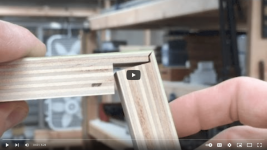The usual way to make a "Miter-Fold" joint in woodworking is to use a 90-degree conical router bit to cut a "Vee" groove in the back of the board, wherein the cut extends very near to the front surface, meaning between 1/32nd and 1/16th material left. The facing edges of the cut are then glued and the (so to speak) free end of the board is lifted until it is at right angles to the base board and the glued surfaces meet. In theory, it is possible to make half-Vee cuts at both ends of a wide board, and make three full Vs at calculated intervals, and then glue up and fold up a complete cabinet shell.
Woodworker Andy Klein invented an improved cut for miter folding. Rockler developed a set of table-saw blades to accomplish this in varying thicknesses of stock. Caveats from Rockler: "Works only on plywood or hardwood between 1/4" and 3/4". Your Table saw must be capable of running an 8'' dado stack and is not compatible with SawStop or any other saws equipped with flesh-detection technology." And, it is expensive... .
https://www.rockler.com/rockler-miter-fold-dado-set-plus
However, if you are making a lot of loudspeaker cabinets, this could be excellent...
with the additional caveat from me is that if you were to say, want to miter-fold a Tower loudspeaker cabinet 9 inches wide 12 inches deep and 38 inches high, you have a big job in front of you in terms of lining up adequate extension tables around your table saw as well as fencing and perhaps clamps and perhaps sandbags or padded bricks to make it all work accurately and safely. That is because to make the shell of a Tower cabinet, you have to start with a board 42 inches wide and 38 inches high, and make cuts centered at Zero inches, 12 inches, 21 inches, 33 inches, and 42 inches. You can rotate the board once you make the cut at 21 inches, but that is still having the fence 21 inches away from the blade.
It seems that the way this dado stack works means that you are pretty much stuck with a table saw. They'd have to re-engineer it to make it CNC-friendly, and that blade stack looks too large for arm saws.
So, perhaps the usefulness for loudspeaker building as a practical matter might be limited to smaller cabinets, but it does have a coolness factor, and the additional gluing area can only help.
cheers,
john
Woodworker Andy Klein invented an improved cut for miter folding. Rockler developed a set of table-saw blades to accomplish this in varying thicknesses of stock. Caveats from Rockler: "Works only on plywood or hardwood between 1/4" and 3/4". Your Table saw must be capable of running an 8'' dado stack and is not compatible with SawStop or any other saws equipped with flesh-detection technology." And, it is expensive... .
https://www.rockler.com/rockler-miter-fold-dado-set-plus
However, if you are making a lot of loudspeaker cabinets, this could be excellent...
with the additional caveat from me is that if you were to say, want to miter-fold a Tower loudspeaker cabinet 9 inches wide 12 inches deep and 38 inches high, you have a big job in front of you in terms of lining up adequate extension tables around your table saw as well as fencing and perhaps clamps and perhaps sandbags or padded bricks to make it all work accurately and safely. That is because to make the shell of a Tower cabinet, you have to start with a board 42 inches wide and 38 inches high, and make cuts centered at Zero inches, 12 inches, 21 inches, 33 inches, and 42 inches. You can rotate the board once you make the cut at 21 inches, but that is still having the fence 21 inches away from the blade.
It seems that the way this dado stack works means that you are pretty much stuck with a table saw. They'd have to re-engineer it to make it CNC-friendly, and that blade stack looks too large for arm saws.
So, perhaps the usefulness for loudspeaker building as a practical matter might be limited to smaller cabinets, but it does have a coolness factor, and the additional gluing area can only help.
cheers,
john
Attachments
I have used lock-miter router bits, and they are a pain to set up properly... this method seems very similar, but easier to execute.
Thanks for reading, and thanks for writing in. I hope that it was pluperfectly obvious that I have not used the Rockler setup, but I did alert my wonderful, Rhode Island School of Design-trained cabinetmaker Corwin Butterworth about it. I did suggest that Richlite's East Coast distributor, which is also a contract fabrication shop, order a kit and try it out.
I am just so taken with Andy Klein's video, and how crisp the cuts are.
Thanks again, john
I am just so taken with Andy Klein's video, and how crisp the cuts are.
Thanks again, john
